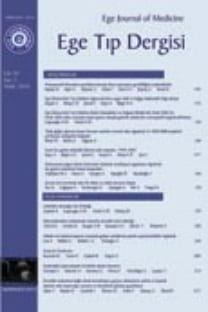Stres inkontinans tedavisinde laparoskopik Burch kolposüspansiyon: 5 yıllık takip sonuçları
Laparoscopic Burch colposuspension for the treatment of stress urinary incontinence: 5-year follow-up results
___
- 1. Stamey TA. Stress Urinary Incontinence. In: Walsh PC, Retik AB, Stamey TA, Vaughan ED Jr (eds). Urinary incontinence in the female. Campbells urology. 6th ed. Philadelphia: Saunders 1992:2829-50.
- 2. Lapitan MC, Cody DJ, Grant AM. Open retropubic colposuspension for urinary incontinence in women. Cochrane Database Syst Rev 2003;(1):CD002912.
- 3. Vancaille TG, Schuessler W. Laparoscopic bladder neck suspension. J Laparoendosc Surg 1991;1(13):169-73.
- 4. Tamussino KF, Zivkovic F, Pieber D, Moser F, Haas J, Ralph G. Five-year results after anti-incontinence operations. Am J Obstet Gynecol 1999;181(6):134752.
- 5. Ross JV. Laparoscopic Burch repair compared to laparotomy Burch for cure of urinary stress incontinence. Int Urogynecol J 1995;6(6):323-8.
- 6. Paraiso MFR, Falcone T, Walters MD. Laparoscopy for genuine stress incontinence. Int Urogynecol J 1999;10(4):237-47.
- 7. Lose G. Laparoscopic Burch colposuspension. Acta Obstet Gynecol Scand 1998;168(1):29-33.
- 8. Bülent Tıraş M, Taşkıran Ç, Onan A, et al. Evaluation of Outcomes of Laparoscopic Burch Colposuspension Concomitant with Total Laparoscopic Hysterectomy. Türk Jinekoloji ve Obstetrik Derneği Dergisi. 2005;2(2):111-15.
- 9. Üstün Y, Üstün YE, Güngör M, Tezcan S. Randomized comparison of Burch urethropexy procedures concomitant with gynecologic operations. Gynecol Obstet Invest 2005;59(1):19-23.
- 10. Walter AJ, Morse AN, Hammer RH, et al. Laparoscopic versus open burch retropubic urethropexy: Comparison of morbidity and costs when performed with concurrent vaginal prolapse repairs. Am J Obstet Gynecol 2002;86(4):723-8.
- 11. Miannay E, Cosson M, Lanvin D, Querleu D, Crepin G. Comparison of open retropubic and laparoscopic colposuspension for treatment of stress urinary incontinence. Eur J Obstet Gynecol Reprod Biol 1998;79(2):159-66.
- 12. Summitt RL, Lucente V, Karram MM, Shull BL, Bent AE. Randomized comparison of laparoscopic and transabdominal Burch urethropexy for the treatment of genuine stress incontinence. Obstet Gynecol 2000;95(4):2-5.
- 13. Dietz HP, Wilson PD. Laparoscopic colposuspension versus urethropexy: A case-control series. Int Urogynecol J Pelvic Floor Dysfunct 2005;16(1):15-8.
- 14. Hong JH, Choo MS, Lee KS. Long-term results of laparoscopic Burch colposuspension for stress urinary incontinence in women. J Korean Med Sci 2009;24(6):1182-6.
- 15. Bulent Tiras M, Sendag F, Dilek U, Guner H. Laparoscopic Burch colposuspension: Comparison of effectiveness of extraperitoneal and transperitoneal techniques. Eur J Obstet Gynecol Reprod Biol 2004;116(1):79-84.
- 16. Zullo F, Palomba S, Piccione F, Morelli M, Arduino B, Mastrantonio P. Laparoscopic Burch colposuspension: A randomized controlled trial comparing two transperitoneal surgical techniques. Obstet Gynecol 2001;98(5):783-8.
- 17. Ostegard DR. Primary slings for everyone with genuine stress incontinence? The argument against. Int Urogynecol J Pelvic Dysfunct 1997;8(6):321-2.
- 18. Geçit İ, Pirinçci N, Güneş M ve ark. Stres inkontinans tedavisinde transobturator tape (TOT) ile transvaginal tape (TVT)in etkinliğinin ve komplikasyonlarının karşılaştırılması. Van Tıp Dergisi 2011;18(4):173-80.
- ISSN: 1016-9113
- Yayın Aralığı: Yılda 4 Sayı
- Başlangıç: 1962
- Yayıncı: Ersin HACIOĞLU
Ablatio plasenta vakalarında perinatal sonuçlar ve plasenta bulguları
N. YILDIRIM, A.Ö. YENİEL, A. M. ERGENOĞLU, A.G.Ş. YILDIRIM, A. AKDEMİR, O. ZEKİOĞLU
H.F. DEMİR, K. DEMİRAĞ, C. BOR, M. UYAR, F.O. ERİŞ
Pseudoxanthoma elasticum and calcinosis cutis
E. E. PALA, Ü. BAYOL, E. USTURALI KESKİN, Ü. KÜÇÜK, G. TÜRE, C. BIÇAKÇI
H.F. DEMİR, A. ERAKGÜN, A. ÇERTUĞ
İ. E. ERTAŞ, A. DOĞAN, A. ÖZDEMİR, U. SOLMAZ, R. GÖKLÜ, Y. YILDIRIM
Ölüm, kayıp, yas ve patolojik yas
Stres inkontinans tedavisinde laparoskopik Burch kolposüspansiyon: 5 yıllık takip sonuçları
F. ŞENDAĞ, L. AKMAN, A. AKDEMİR, K. ÖZTELİN
Yaşlı insanların sosyal dışlanmasına karşı hukuki çalışmalar: Çin örneği
Yanlışlıkla intra-arteriyel atrakuryum enjeksiyonu yapılan pediatrik olgu
Ö. Z. ÖZDİNÇ, K. EVREN ŞAHİN, A. GÖKTAY, M. ONAY, E. TERCAN
Floroskopi rehberliğinde göğüs duvarından yabancı cisim çıkarılması
